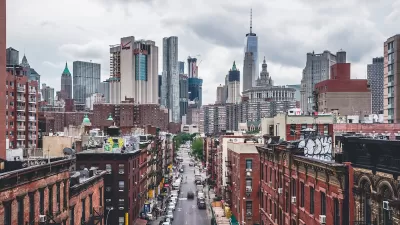Leonardo Da Vinci gets credit for many inventions and creative breakthroughs, but his contributions to the theory of city making gets less credit.

Leonardo Da Vinci died 500 years ago on May 2, and Allesandro Melis writes to describe the great thinker and artist's role in the birth of urbanism in the 15th century.
"Although the Renaissance is renown as an era of incredible progress in art and architecture, it’s rarely noted that the 15th century also marked the birth of urbanism as a true discipline," according to Melis. Da Vinci was one of the thinkers contributing to this nascent field of intellectualism. "Around 1486—after a pestilence that killed half the population in Milan—Leonardo turned his thoughts to urban planning problems. Following a typical Renaissance trend, he began to work out an 'ideal city' project, which, due to its excessive costs, would remain unfulfilled."
Melis shares a reconstruction of da Vinci's work on the subject of a new city along the Ticino River, as collected in Paris manuscript B and Codex Atlanticus. Among numerous innovative propositions, "the true originality of Leonardo’s vision was its fusion of architecture and engineering," according to Melis. "Leonardo made designs for extensive hydraulic plants to create artificial canals throughout the city. The canals, regulated by locks and basins, were supposed to make it easier for boats to navigate inland and transport goods."
"Leonardo also thought that the width of the streets ought to match the average height of the adjacent houses: a rule still followed in many contemporary cities across Italy, to allow access to sun and reduce the risk of damage from earthquakes."
Melis concludes by describing da Vinci's ideas as relevant in contemporary times, as well as models for the future of urban planning.
FULL STORY: The Urban Planning Vision of Leonardo da Vinci

Alabama: Trump Terminates Settlements for Black Communities Harmed By Raw Sewage
Trump deemed the landmark civil rights agreement “illegal DEI and environmental justice policy.”

Planetizen Federal Action Tracker
A weekly monitor of how Trump’s orders and actions are impacting planners and planning in America.

The 120 Year Old Tiny Home Villages That Sheltered San Francisco’s Earthquake Refugees
More than a century ago, San Francisco mobilized to house thousands of residents displaced by the 1906 earthquake. Could their strategy offer a model for the present?

San Francisco Opens Park on Former Great Highway
The Sunset Dunes park’s grand opening attracted both fans and detractors.

Oregon Legislature to Consider Transit Funding Laws
One proposal would increase the state’s payroll tax by .08% to fund transit agencies and expand service.

Housing Vouchers as a Key Piece of Houston’s Housing Strategy
The Houston Housing Authority supports 19,000 households through the housing voucher program.
Urban Design for Planners 1: Software Tools
This six-course series explores essential urban design concepts using open source software and equips planners with the tools they need to participate fully in the urban design process.
Planning for Universal Design
Learn the tools for implementing Universal Design in planning regulations.
Clanton & Associates, Inc.
Jessamine County Fiscal Court
Institute for Housing and Urban Development Studies (IHS)
City of Grandview
Harvard GSD Executive Education
Toledo-Lucas County Plan Commissions
Salt Lake City
NYU Wagner Graduate School of Public Service





























